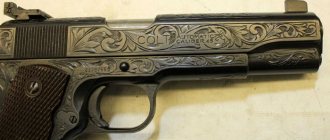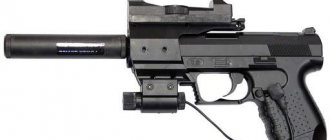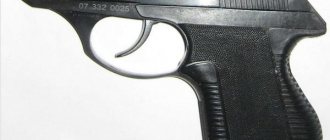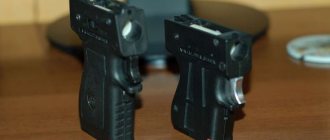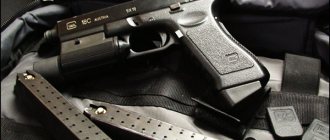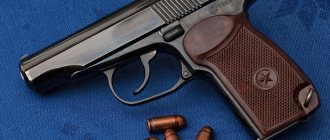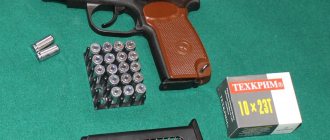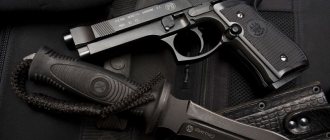History of creation
The predecessor of the model - Walter PP was released in 1929, Walter PPK - in 1931 as a shortened and lightweight model, with some design features. The barrel length and the overall length of the model, height were reduced, the design of the frame and the front part of the bolt changed.
The PP model was one of the first to be made from an alloy rather than steel, a design solution that reduced weight. The model was evaluated by experts. A new, compact version was created for the police to be worn concealed under clothing by officers and detectives. The result of the work was “Walter PPK” (Polizei Pistole Kriminal).
"Walters PPK" were actively used in the Second World War. They were in service with the police and intelligence services, and were used as personal weapons by Luftwaffe and Navy officers and senior Wehrmacht officers.
From the 1960s, the manufacturer began producing them again, and production continued until the end of the 20th century. Now the model is manufactured in PPK and PPK/S versions chambered for 9x17 mm. Based on the combat “Walter PPK”, various arms companies produce traumatic versions:
- Umarex Walther mod. PP, chambered for 10×22 mm T. The model is certified in the Russian Federation as a gas pistol that can use rubber bullets.
- ERMA RR-T, chambered for 9 mmA. Produced by the model, production began in 2010. The bolt of the weapon is steel, the frame is made of aluminum alloy.
- EPMA 55P, uses 9 mmA cartridge. Also products.
Of the three versions, EPMA 55P is most similar in appearance to the Walter PPK.
Criteria for choosing an air gun
All models presented for sale differ in performance characteristics and price. In order not to make a mistake when purchasing, you should immediately pay attention to the best air pistols, which are time-tested and have accumulated quite a lot of positive reviews. As for technical characteristics, the following points are fundamentally important :
- Power . One of the main parameters that you need to focus on. The power value that will vary for each air pistol will be the bullet's ejection speed. A good indicator is considered to be from 100 m/sec.
- Weight and shape . A convenient weapon should be moderately weighty and fit comfortably in the hand. Pistols for beginners usually weigh about 700 g, for professionals - from 830 g. The shape is preferably rounded, although this is a matter of personal taste.
- Type of bullets, their number . Bullets are cast from lead, steel, and galvanized shot.
- The material at the base of the pistol grip . There are different options - plastic, wood. The first, although cheaper, is not as reliable.
Additional options will be very useful in many cases. For example, a rubberized handle will prevent slipping, an adjustable finger groove and palm rest will make it more comfortable to grip the weapon, a manual safety will be appropriate for beginners, and an automatic safety will be suitable for professionals as an additional factor in their own safety. There may also be a tactical flashlight, an optical sight, and a laser target pointer.
When deciding which air gun is better to take, do not forget about the appearance. There are models on sale that are made with accurate imitation of popular types of military weapons.
general description
The weapon's automatic operation works thanks to the recoil of a free bolt, which completely encloses the barrel. A trigger-type trigger can be released by self-cocking or with a previous cocking of the hammer. At the rear of the bolt there is a non-automatic safety lever. The cartridges are in a single-row removable magazine.
The handle may have a pad for additional support for the shooter's hand. The magazine latch in the form of a button is located behind the trigger guard, on the left side, on the frame. After the cartridges are used up, the bolt delay is activated. There is an indicator that shows whether there is a round in the chamber. It is shaped like a pin protruding from the rear of the bolt above the hammer.
The frames of modern 9 mm Walter PPK models have an elongated protrusion that protects the hand from being hit by the trigger or bolt during a shot. This is how they differ from the original frames produced in German pistols.
The pistol is available in different modifications, powered by caliber cartridges. In total, more than a million copies were made. The most popular model was a pistol chambered for 7.65x17 mm.
Rubber-running pistols
The most beloved traumatic pistol by Russians, “Makarych” (Izh-79-9T), costs 7,800 rubles. Buy “cheeks” identical to the combat version - another 500 rubles. Buy a nickel-plated version - another couple of thousand. Full tuning will cost 32 thousand rubles.
Firearms, traumatic weapons - in the context of the ban on the storage and carrying by private individuals of service and combat - are becoming increasingly popular.
Dozens of manufacturers, both domestic and foreign, are meeting the desire to protect themselves and just shoot for fun. However, the client most often does not understand what he is buying, and therefore the purchase can turn against him. The last time “Money” studied the market for traumatic firearms was six years ago, almost immediately after the adoption of the law “On Weapons.” Then, in fact, there was almost nothing to study: the barrelless four-shot “Wasp” (this does not mean a portable missile launcher that destroys loitering enemy targets, but a completely hand-held complex that fits in the palm of your hand and is suitable for temporarily neutralizing a human aggressor from a distance of 2-5 m), and even a newfangled pistol at that time, “Makarych”, a copy of the combat PM, firing rubber bullets.
Today the situation is fundamentally different. On the shelves of large specialized stores there are dozens of barrelless and short-barreled firearms of both Russian and foreign production. What is better and more effective: “barrelless” or “short-barreled”, samples made in Russia or made abroad? Let's try to figure it out.
The above-mentioned “Wasp” (labeling PB-4) produced by the Sergiev Posad Research Institute of Applied Chemistry has undergone some improvements. They mainly concern the “ignition system”. If in the first copies the ignition of gunpowder in the cartridge occurred from a spark provoked by a piezoelectric element, today the process can occur from a battery, or even from a mini-generator. The consumer appreciated the improvements: there were much fewer misfires. Perhaps the main inconvenience of the Wasp is its excessive “fatness” (after all, there are four chambers - it will definitely stick out of your pocket).
The size problem was solved in a competing company (Izhevsk). Here, the Strazhnik barrelless complex, announced five years ago, was finally brought to fruition. The technological solution is simple: instead of four chambers there are two, that is, the weapon has become flat and light (all components, like in the Wasp, are made of plastic), and replacing a shot two-shot unit with a new one is a matter of seconds. The rest - from the cartridge to the price (5-8 thousand rubles) - is identical in “Osa” and “Guardian”. In both cases, powerful 18 x 45(!) mm caliber cartridges are used. Moreover, in three versions: traumatic (with a rubber bullet), light-noise and signal (red and green fire). The latter may be good for hunters, but are ridiculous in conditions of domestic aggression - unless they attract attention. Therefore, “signals” are almost never sold out. The light and noise ones also disperse sluggishly. A shot with such a cartridge is accompanied by a flash of almost 4 million candelas, and the noise effect is comparable to the roar of a low-flying attack aircraft - 150 decibels. That is, before shooting, the shooter, as if aiming a mortar, must close his eyes and open his mouth so as not to go blind or deaf.
The former Soviet six-shot “general's pistol”, converted to fire rubber bullets, fits perfectly in a handbag, not inferior in shot energy to the most powerful systems
The most common type of cartridge in barrelless weapons is a bullet. The price is the same - 65-70 rubles. per piece, but the traumatic effect. It can be used to inflict injury incompatible with life. And such cases, according to Deputy Chairman of the State Duma Committee on Security Anatoly Kulikov, are becoming more frequent. According to the law, it is prohibited to use firearms aimed at the head area and from a distance of less than a meter. In fact, a bullet fired from an “Osa” or “Guard” cartridge, even from three meters, if it hits the middle left part of the sternum (in the heart area) or in the right hypochondrium (in the liver area), can cause the formation of deadly hematomas. In any case, rib fracture is guaranteed.
The Deneg correspondent, with the assistance of Leonid Zhidkov, general director of private security company Kolontaevo-Shield, recently conducted an experiment: he fired three rounds from the Strazhnik. A garage door and an old quilted jacket were used as guinea pigs. They shot at the door twice from five meters. The bullets pierced the millimeter-thick steel sheathing and drilled another half-centimeter into the board underneath. True, the spread was very large - about a meter (this is due to the lack of barrels, which reduces aiming to a minimum). The padded jacket, rolled up, was hit at point-blank range. The rubber bullet stuck in the cotton wool was removed and placed in the flame of a gas burner. Under the rubber layer was a metal core about a centimeter in diameter. Using a magnet, we were convinced that it was not non-ferrous metal, but steel.
Leonid Zhidkov said that he is trying to limit the use of service weapons such as PMM or Izh-71 in his units and switch (where it is situationally justified) to barrelless traumatic options - not so impressive, but relatively humane.
The two-shot "Guard" is completely flat - easily and discreetly fits in the back pocket of jeans
The almost lethal force of barrelless firearms is due not only to the presence of a steel core in the rubber bullet. There is also a legal issue. The Weapons Law regulates one of the main indicators of “lethality”—the initial energy of a projectile—only for short-barreled systems, that is, pistols. In this regard, nothing is said about barrelless weapons such as “Wasp” and “Guardian”. Therefore, the energy of a shot from them reaches the prohibitive 85-90 J.
There are persistent rumors that the situation will soon change, and an amendment will be made to the law limiting the power of the 18 mm cartridge. On the other hand, a year and a half ago, the bar for the maximum permissible energy of a cartridge with a rubber bullet for pistols was raised from 35 to 50 J. And with this began a new chapter in the history of the Russian traumatic firearms market.
As already mentioned, there is plenty to choose from. Imports are represented by almost all brands producing both service and military short-barreled weapons. Ours also expanded the range by copying popular combat options (those that appear in the movies). According to the head of the traumatic weapons department of the Kolchuga store-salon, Maxim Ryabov, the undisputed sales leader in this segment of the arms market is traditionally the Makarych model - a copy of the Makarov pistol labeled Izh-79-9T. According to the sellers’ recollections, queues lined up for the first Makarychs five years ago, like people lined up for sausage in Soviet times. Today in the same “Kolchuga” on the street. Varvarka, 15-20 barrels are sold daily at a price of 7800 rubles. for the standard eight-shot version. There is also a ten-shot modification - nickel-plated, engraved, and sometimes even inlaid with “Makarych”. The price of this reaches 32 thousand rubles. Moreover, even if the weapon once suffered from defects, today there are practically no returns (the product warranty is one year).
Specifications
The pistol weighs 590 g, has a length of 15.5 cm, a barrel length of 8.3 cm, a weapon width of 2.5 cm, and a height of 10.9 cm.
The barrel has 6 longitudinal right-hand rifling.
The cartridges used are 7.65x17mm, 9x17mm, .22LR, 6.35x15mm. The magazine holds 7 7.65x17mm and 9 .22 LR ammunition. The initial speed that a 7.65 main caliber bullet develops after exiting the barrel is 280 m per second. Muzzle energy 186 J.
Dismantling "Walter"
Disassembly of the Walter PPK is carried out in the same way as the Makarov pistol, for which the Walter was used as a prototype. Partial disassembly is necessary for inspection, cleaning and subsequent lubrication; complete disassembly is done if the weapon is heavily soiled, has been exposed to rain, before repair, if new lubricant is used for the first time. Disassemble the parts carefully, without excessive force or sudden jerks.
- Disassembly sequence:
- Remove the magazine from the base of the handle.
- Disconnect the shutter from the frame.
- Remove the recoil spring from the barrel.
Assembly is done in reverse order, and you need to pay attention to the numbering of parts to do everything correctly.
Advantages and disadvantages
Among the advantages, it is worth noting its compactness, which is why the Walter PPK is suitable for concealed carry and its light weight. The model has excellent stopping power. The advantages include a self-cocking firing mechanism, thanks to which you can fire the first shot without cocking the hammer, and the presence of an ammunition indicator in the chamber. The pointer is a signature feature of Walter pistols. The PPK model has a modern design, ease of use, and is convenient to use.
Disadvantages: noticeable recoil, the weapon bounces when fired with a powerful cartridge due to the non-fixed barrel.
The Walter PPK is still popular among the police in European countries due to its convenience, compactness, and good stopping power. The model remains trouble-free in operation due to the simple execution of a rather complex design. The weapon is manufactured with an emphasis on safety and can be carried without a holster in a pocket or on a belt.
The fuse does not allow an accidental shot to occur, and smooth surfaces and slightly protruding relief parts do not cling to clothing. The safety function is also performed by a pin indicating that the cartridge is in the chamber.
About the design
The automatic operation of the Walter PPK and PP pistols operates due to recoil when the bolt is free. The weapon has 39 parts. The rifle unit is equipped with a double-action trigger mechanism, a twisted cylindrical mainspring, the location of which is the pistol handle. Shooting is carried out from self-cocking with a trigger force of 5.9 kg and with the trigger cocked - 2.7 kg. The trigger rod was installed in a slot in the pistol frame and closed with a bolt. The left side of the bolt housing is equipped with a safety lock. As with other German-made pistols, the Walther is ready for use once the flag is moved to the top position. During deactivation of the weapon, the hammer is automatically decocked and the trigger and firing pin are safely locked. There is no bolt locking in this pistol, so reloading is possible even with the safety on.
According to experts, the peculiarity of the firing mechanism is that in a weapon with the safety trigger uncocked, the trigger position will be in the front position, and when it is cocked, it will be in the rear position. If the safety is turned off, the trigger will move forward. German pistols do not have a Colt safety cock. In his shooting products, F. Walter used a scheme for separating hammers and firing pins, due to which the pistols turned out to have a more complicated design, but were quite reliable and safe. If the weapon falls on a hard surface, there will be no shot due to the vertically located and spring-loaded disconnector. The hammer will not interact with the firing pin until the disconnector is raised with the sear. If the trigger suddenly breaks, it will be stopped by the disconnector protrusion. The trigger lock is released when the triggers are fully moved. At the same time, the disconnector is raised, and its protrusion is installed near the trigger groove.


